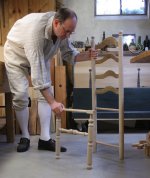All,
I have been in contact with the seamstress (Margaret) who made Mike's shirt that he bought on Ebay. I asked her if she had or would have any other Men's XL shirts available similar to the one Mike bought off Ebay, she does not but would be happy to make some for us. Here's the link to Mike's shirt:
http://cgi.ebay.com/ws/eBayISAPI.dll?ViewItem&item=330234706957&ru=http%3A%2F%2Fsearch.ebay.com%3A80%2Fsearch%2Fsearch.dll%3Ffrom%3DR40%26_trksid%3Dm37%26satitle%3D330234706957%26category0%3D%26fvi%3D1
The price for a Muslin XL like the one above would be $15 plus $10 shipping (to Scandia) and Paypal fee.
She also has another style available, here's the link: http://cgi.ebay.com/ws/eBayISAPI.dll?ViewItem&item=330238542613&ssPageName=ADME:X:RTQ:US:1123
Disregard the color of the shirt, she would make this out of muslin, or another fabric if we chose (she would have to price out the fabric and get back to us.) Cost for a Muslin XL would be $10 plus $10 shipping (to Scandia) and Paypal fee.
I just ordered a 4 button in XL in Muslin. If anyone else is interested in ordering a shirt, send Margaret an email at [email protected] If you would like to split the shipping costs, mention that you would like your order shipped with Bart Genovese's order. You would be responsible for picking up the shirt from me, or I will be happy to bring it to the Landing in August.
Hope this helps...talk soon!
Bart
I have been in contact with the seamstress (Margaret) who made Mike's shirt that he bought on Ebay. I asked her if she had or would have any other Men's XL shirts available similar to the one Mike bought off Ebay, she does not but would be happy to make some for us. Here's the link to Mike's shirt:
http://cgi.ebay.com/ws/eBayISAPI.dll?ViewItem&item=330234706957&ru=http%3A%2F%2Fsearch.ebay.com%3A80%2Fsearch%2Fsearch.dll%3Ffrom%3DR40%26_trksid%3Dm37%26satitle%3D330234706957%26category0%3D%26fvi%3D1
The price for a Muslin XL like the one above would be $15 plus $10 shipping (to Scandia) and Paypal fee.
She also has another style available, here's the link: http://cgi.ebay.com/ws/eBayISAPI.dll?ViewItem&item=330238542613&ssPageName=ADME:X:RTQ:US:1123
Disregard the color of the shirt, she would make this out of muslin, or another fabric if we chose (she would have to price out the fabric and get back to us.) Cost for a Muslin XL would be $10 plus $10 shipping (to Scandia) and Paypal fee.
I just ordered a 4 button in XL in Muslin. If anyone else is interested in ordering a shirt, send Margaret an email at [email protected] If you would like to split the shipping costs, mention that you would like your order shipped with Bart Genovese's order. You would be responsible for picking up the shirt from me, or I will be happy to bring it to the Landing in August.
Hope this helps...talk soon!
Bart

